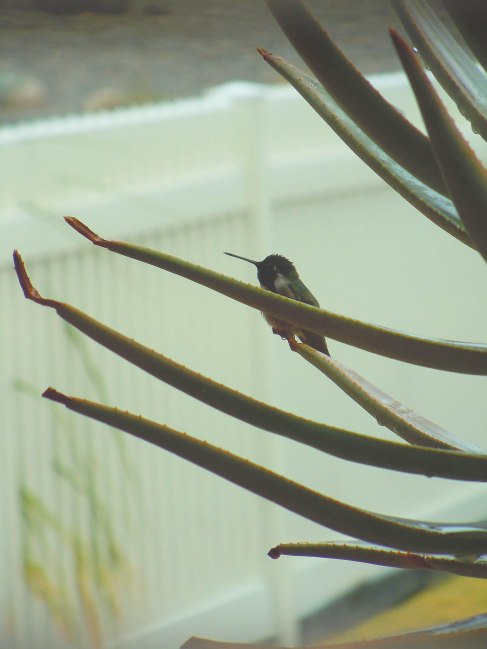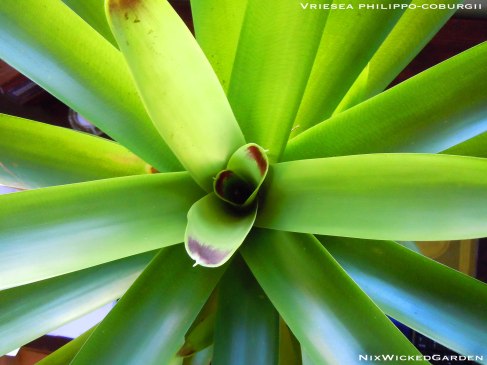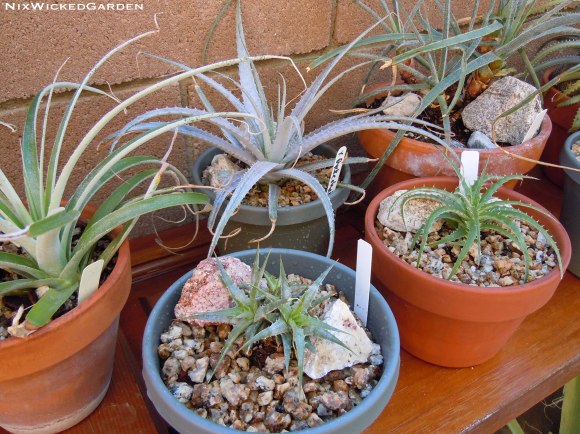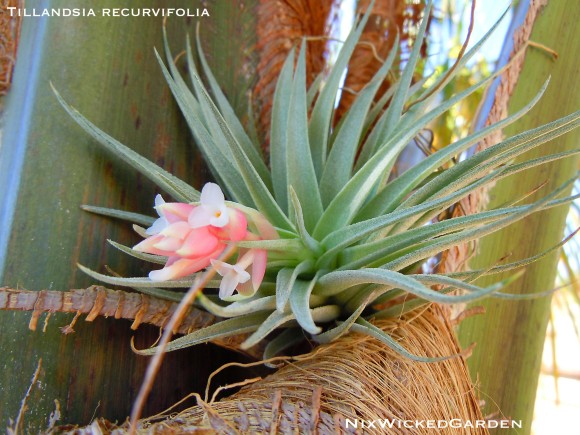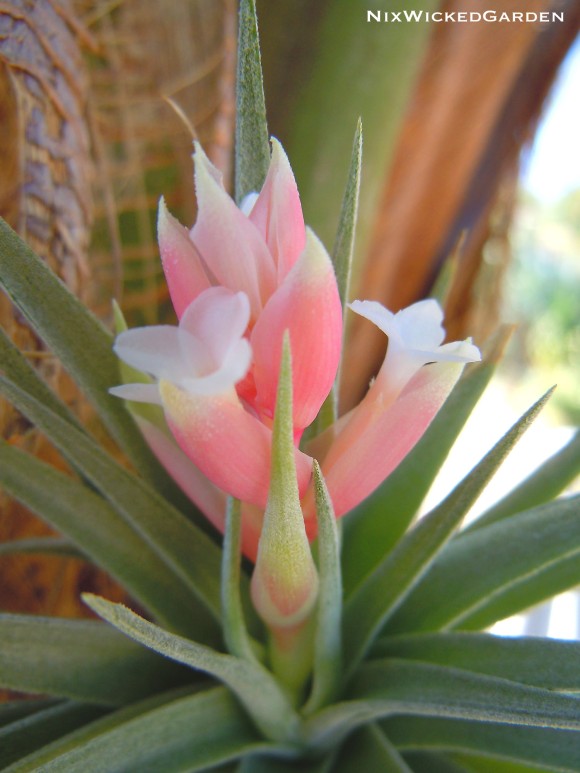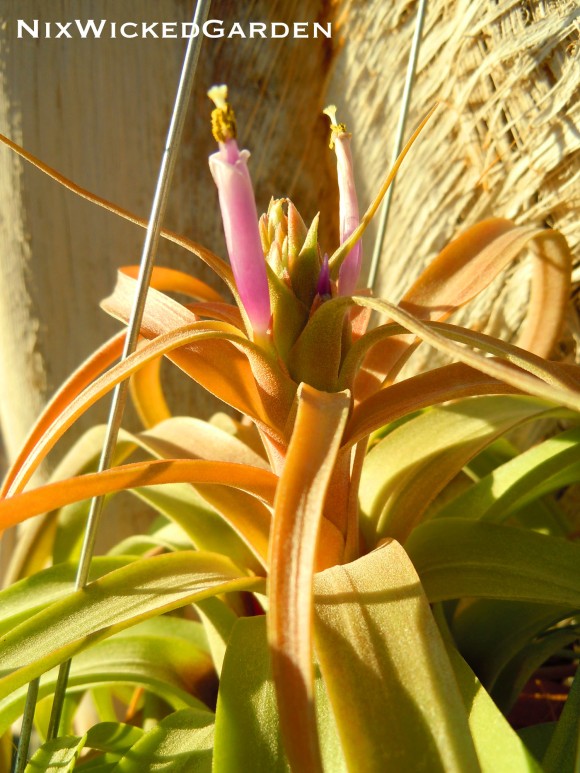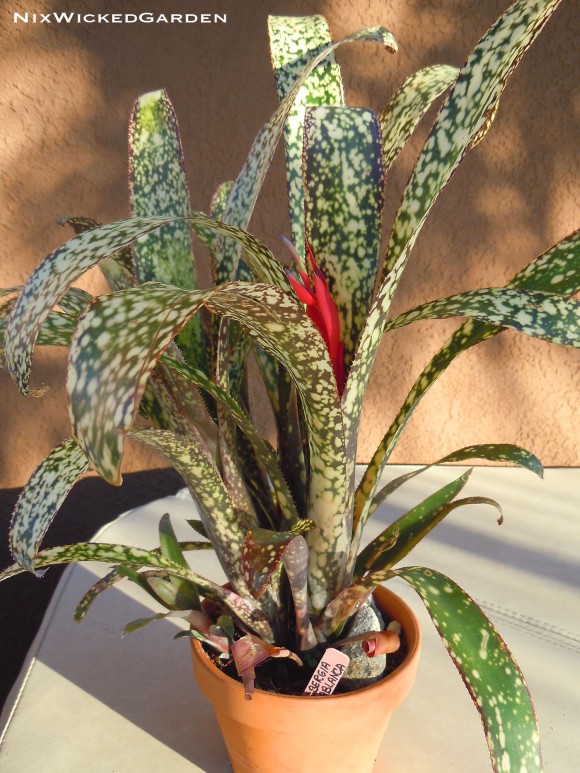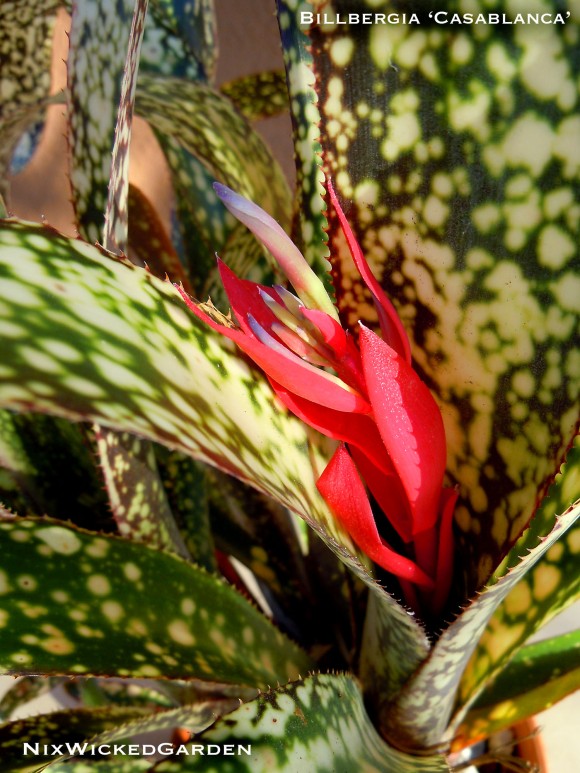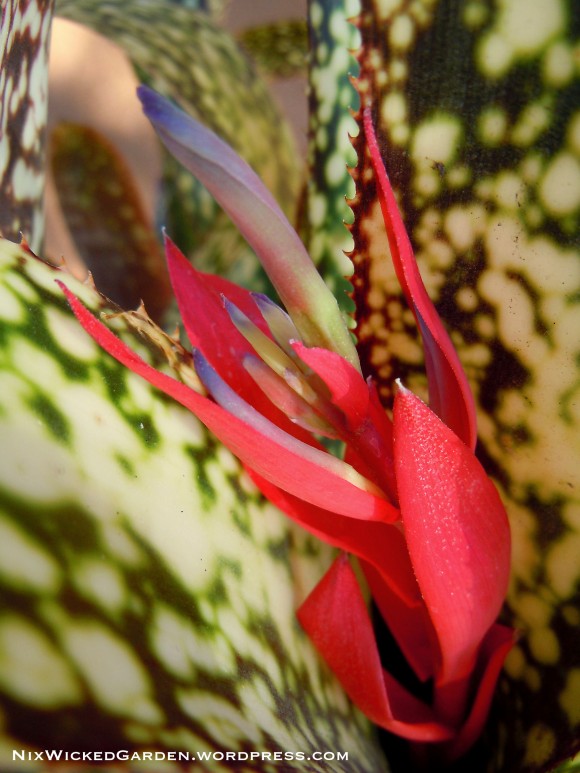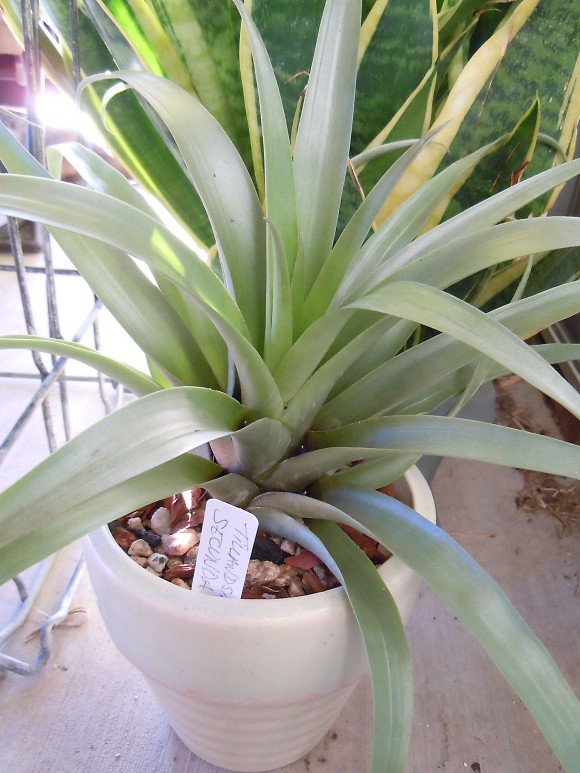Taking a minute to post more pics with some words about some of my favorite (and one, NOT so favorite) plants. Above is a tree that my Partner and I planted 2 years ago (Hmm, could be 3!). It is a Cercidium x’Desert Museum’, aka: ‘Desert Museum’ Hybrid Palo Verde. Much easier to prune than the wild Palo Verdes one sees growing roadside here in the Coachella Valley–since it is virtually thornless. Good news for me, because this fast growing tree needs quite a bit of constant clipping and shaping to keep it from blocking my way into the driveway! This semi-evergreen, Palo Verde hybrid exhibits qualities found in several other Palo Verde varieties. It provides ample filtered shade, distinctive rich green trunks and branches that, similar to Palo Brea, stay smooth as they get older. Crazy abundant brilliant yellow flowers that resemble tiny orchid blooms that appear in spring and intermittently during the summer months. If you are interested in obtaining one of these beauties to adorn your own yard and you happen to be allergic to bee stings—Beware! Whilst the tree is in bloom, walking past it to get to our mailbox can be an unnerving experience, as the entire canopy emits a sub-bass vibrating hum from literally thousands of bees that swarm these trees for pollen. I had a long series of allergy shots (over 3 years worth) for many allergens, including bee venom–I don’t go into anaphylactic shock from 1 or 2 stings, but more than 10 might take me out!! Yet and still, I love this tree. I give the bees some space and move slowly near it without making noise when collecting the mail–just in case!
The Bougainvillea in the photo is our neighbors. Bougainvillea are woody, thorny vines that bloom with an explosion of colorful flowerlike bracts nearly all year here in the Desert. They are South American natives. Although I think they are very pretty, and I like seeing them jazz up the landscapes around town, when we bought this house we pulled out all of the Bougainvilla on the property (If any of you readers happen to have a swimming pool, you will understand why!) Not only do they make a HUGE mess in the yard and swimming pool, when we have our front door open with the swamp-cooler on, our neighbors bushes drop tissue-paper-like fallen leaves which blow right into our house under the security screen door. It breaks apart and disintegrates on contact and stains our light ceramic tile when trying to clean it up. I guess it wouldn’t be so bad if we had a pool-boy, gardener and housekeeper to deal with all this mess—but we don’t. WE do all this work, so it is not my favorite plant…Not by a long shot!
The plant in the multi-photo collage above is my Bromelia balansae offset that I transplanted from a hedge-colony I have growing in the backyard just a few months ago. This illustrates the start of the bloom cycle for this attractive, yet scary Terrestrial Bromeliad. This species resembles B. pinguin. However, it does not grow as large and so it is cultivated more often. This plant was originally given to me by plant nursery owner, Gary Guarino. He had a nursery on Hyperion in Silverlake, Los Angeles for many years. I was buying other plants and he asked if I wanted the two pots of it that he had there. I’ll never forget how he got me to take them home with me: “You want ’em? They’re YOURS—PLEASE get them out of here!!” He exclaimed, “I am so f**king sick of these bastards BITING ME!!” He didn’t recall the name of the plant. Someone had ordered them years before and never came to claim them. It wasn’t till a clone of it first bloomed for me at my house in Palm Springs, that I realized the prize that I had. B. balansae is by far the hardiest, most prolific and regular bloomer of any of my plants. It is also my favorite Bromeliad. Probably because it is hard to handle, but it’s wicked-beauty eventually shines through!! It was Charles Plumier, a French botanist, that named this genus in honor of the Swedish physician & botanist Olf Bromelius (1639-1705). This fine name rolled off the tongue nicely and also gave rise to the name of the family. BROMELIACEAE, or in plain English: the bromeliads. The genus Bromelia consists of approximately 50 species. With a few exceptions, they are large plants with heavily spined leaves, that grow from 1 or 2 meters long. In rural areas, some of these species are grown as living fences, since their barbed spines create an impenetrable barrier for humans & even cattle. Because of this species of Bromelia are not considered suitable for cultivation in the home or even greenhouses. But, I love them! So far, I have B. balansae, B. serra and a small pup of B. karatas (He is supposed to eventually get as big as 8 feet tall, ten feet wide!). I am DESPERATE to find a good clone of Bromelia irwinii. So, if anyone knows where I can buy one, PLEASE leave me a comment!!! I’d be forever grateful!!! 🙂 The distribution of Bromelia ranges from throughout Mexico, Central America, South America and the West Indies.
I will follow up with a post once this plants flowers have emerged, as well as when the plum sized yellow edible fruit develop (once the flowers have all bloomed out).
Apparently, there is some controversy surrounding the plant pictured above. Not only does it closely resemble a narcotic drug chemical producing species named Trichocereus Pachanoi. It also looks like many other cacti species, leading to misidentification and a lot of confusion. The name printed on the label when I bought the first column of it 9 years ago was Cereus Peruvianus. It has been called “The Least & Best Known Cactus” as well as Mexican Fence post Cactus (which it isn’t–I have some of those and that one has whitish defined margin edges and it is a “fatter”, greener plant. Mine is very blue which is the same color as the Trichocereus (which would explain why Stoners keep stealing the plants I have planted by the street! News Flash, dummies: YOU AREN’T GOING TO GET HIGH SMOKING MY CACTUS! This is the more common, garden center ornamental plant that grows well, produces big lovely, night-blooming flowers (pollinated by bats) and gives every garden that Touch-of-Southwest flair. I really love this plant!
Now, I’d like to introduce a couple of Aloes that aren’t supposed to do well here in the Desert–but I got them anyway! Aloe plicatilis & Aloe polyphylla. Both these plants I have wanted for a VERY long time. I kept getting scared away from buying either one because of the “picky nature” of these particular Aloes. If it is too hot & humid, they implode. One is very sensitive to frost. Both need protection from all day direct sun (most Aloes appreciate at least partial half-day shade—but, these guys are temperamental!) Both are very expensive to buy as mature specimens. And, hey! Why shell out a ton of cash if they aren’t going to make it through either the summer or winter? I decided to experiment and see if I can keep them alive…
Aloe plicatilis is a unique and striking plant, that given time—(lots and lots of time!) grows into a multi-branched tree aloe. Large specimens grow up to 5 meters high in advanced maturity. It is considered one of the botanical treasures of South Africa. The strap-shaped leaves grow in 2 opposing rows, each cluster resembling an open fan (hence the common name: Fan Aloe). It’s habitat and distribution are very limited. A. plicatilis is found only in the western Cape mountains of South Africa. They grow on steep rocky slopes in well-drained, acid sandy soils. It grows in high rainfall areas at an altitude from 500-2300 feet. Although I took the photo of my plant outside, I grow him the bright window of my studio/office–At least for the hot spring/summer. Maybe in the fall he can spend some time out on the covered patio. But for now we are already experiencing highs of 109-111°!! I special ordered this one from Moller’s Garden Center in Palm Desert, CA a few months ago. I was warned by the manager there that it might not survive here in our extreme heat. The plant was brought up from a grower in San Diego (a much more mild climate!) This plant will tolerate light frost only. Prolonged exposure to freezing temperatures will cause the leaves to blacken and drop off. Although it comes from a area with high rainfall, it doesn’t like to be watered too much in the summer or winter. Protection from high summer rainfall is very important. The monsoon humidity coupled with extreme heat we get here in the summer (late July to early Oct.) can also destroy the plants water circulation & storage systems and cause the plicatilis cellular structures to collapse. These are some reasons for keeping this little guy as a houseplant where it is a comfortable 72-79° inside with the evaporative cooler running!
Aloe polyphylla, aka: Spiral Aloe is another “sensitive-type” succulent. This high altitude species from Lesotho is one of the most spectacular plants of southern Africa. You can’t really tell yet because of how young this little guy is. Look up Spiral Aloe with your search engine and look at some mature plant examples to see what I mean. It doesn’t seem that this plant is real when you see how cool the spiral structure is! The plant has to grow to certain size before it begins to spiral clockwise or counter clockwise. This is so the plant can optimize leaf surface area for sun-exposure. This plants habitat and distribution is restricted to steep basaltic mountain slopes in Lesotho, at altitudes above 6600 feet. Moisture from clouds and mist adds to the annual rainfall there which can be over 40 inches! The plants are often covered under snow in winter. These plants are very sensitive to warming of their roots. In their natural habitat during the warmer months their roots are usually bathed in a constant stream of ice-cold water with very little soil to speak of. I was instructed to plant this Aloe in a shallow ceramic container to prevent saturation at the bottom of a deep pot. Also, to place the container at at an angle to aid in water drainage. This polyphylla is planted in a mixture of crushed volcanic rock, perlite, orchid bark, sand and a bit of peat moss & cactus mix. As long as the plant isn’t in humid hot weather, it should be alright. If it gets too muggy, I will bring him inside. If he makes it till winter, he can remain outdoors for bright light, but little water. If it starts raining, I will have to move the plant under the covered patio. Whew! It is a lot to try and remember, but I will endeavor to keep this cool, endangered plant alive!
This little plant I have was seed grown in northern California and is approximately 10 years old. Despite being protected by law, numbers in the wild have declined rapidly in recent years because of unscrupulous collectors who sell the plants to local people and tourists. Despite the fact that plants dug up from their natural habitat almost never transplant successfully. They take a very long time to repopulate their numbers. They don’t flower very often and usually do not offshoot new pups. The protected status of the plant unfortunately only seems to make it more desirable. Here’s hoping I can keep one of these groovy plants thriving! 🙂



























